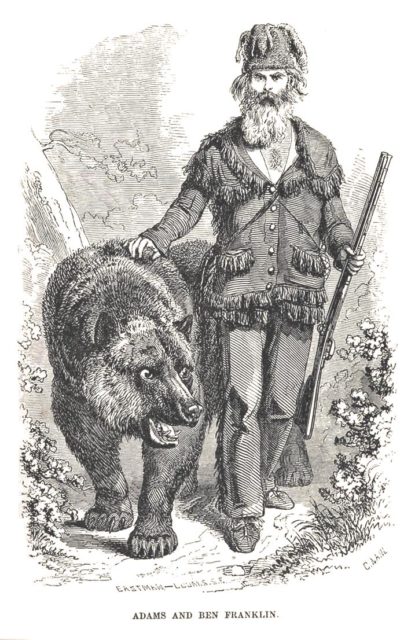The story of ‘Grizzly Adams’ is one of the most amazing frontier biographies ever documented.
Adams was an adventurous lad who loved exploring the swamps and woodlands of his home. As he grew to manhood, John ‘Grizzly’ Adams recognized an uncanny ability he had when it came to understanding the behavior of wild animals. However, after being nearly killed by a Royal Bengal Tiger when he was twenty-one, he opted for a trade as shoemaker, something his father, Eleazer had him apprentice at during his teen years.


Adams tried his luck at mining, hunting game to sell to the miners, trading, and finally, ranching and farming. At times he was rich and then, just as quickly, broke. Late in 1852, having lost his ranch outside of Stockton, California to creditors, he took the few items he could salvage and turned his back on civilization by seeking refuge in the Sierra-Nevada Mountains near Yosemite. There, Adams built and lived in a cabin surrounded by wildlife and friendly Native American tribes. He learned to commune with nature and, became an expert hunter, tracker, and provider for both himself and his Indian friends. He also captured, raised, and trained Grizzly Bears (as well as a variety of other wild animals).
Using his most beloved Grizzly Bears as pack animals — Lady Washington, General Fremont, and Benjamin Franklin — John ‘Grizzly’ Adams led many tracking expeditions. He traversed as far north as the Canadian border, as far south as the Mojave Desert, and as far east as Salt Lake City. He hired Indian scouts to help him on his journeys, further solidifying his relationship with tribal leaders as the legend of ‘Grizzly Adams’ grew.
Adams lived the life of a mountain man for three years, until 1856, when he relocated to San Francisco after being offered a chance to make money by putting on shows with his animals. While running this enterprise he adapted to city life again, and he and his ‘Mountaineer Museum’ became so popular that the newspapers began to take notice. One newspaper writer, in particular, Theodore Hittell, wrote an impressive series of articles about Adams and his animals, bringing them even greater popularity.
By the end of the 1850’s, Grizzly Adams’ health was deteriorating, and he knew his life would soon end. Since he had been away from his wife in Massachusetts for over ten years, he wanted to earn enough before he died to leave her a comfortable sum. He made arrangements to relocate his menagerie and collections to New York in hopes of joining P.T. Barnum as a part of his show.
In New York City, Grizzly Adams, joined with P.T. Barnum to perform his California Menagerie in a canvas tent for six weeks. His health continued to decline, and after a doctor told him he had better settle his affairs, Adams decided he would sell his menagerie to Barnum. From the proceeds of the sale of the menagerie and the bonus, he had accomplished his goal of providing a comfortable sum for his wife.
In 1855, Adams suffered head and neck trauma during a grizzly attack in the Sierras of California. His scalp was dislodged, and he was left with a silver dollar-sized impression in his skull, just above his forehead. Adams had made pets of several grizzlies and often wrestled with them while training them and in exhibitions. During one such bout, his most delinquent grizzly, General Fremont (named for John C. Fremont), struck Adams in the head and reopened the wound. It was subsequently reinjured several times, eventually leaving Adams’ brain tissue exposed.
The damage was further exacerbated while Adams was on tour with a circus in New England during the summer of 1860, when a monkey he was attempting to train purportedly bit into the wound. After more than four months performing with his California Menagerie, complications from the injury led to Adams’ inability to continue with the show. After completing his contract with P.T. Barnum, he retired to Neponset, Massachusetts, where he died of illness (possibly meningitis) just five days after arriving at the home of his wife and daughter. Upon hearing of Adams’ death, Barnum was deeply grieved.
Adams was interred at the Bay Path Cemetery in Charlton, Massachusetts. It is believed P.T. Barnum commissioned the creation of his tombstone. Also buried there nearby are his mother, father, a sister, his wife, his son and one of his two daughters.

